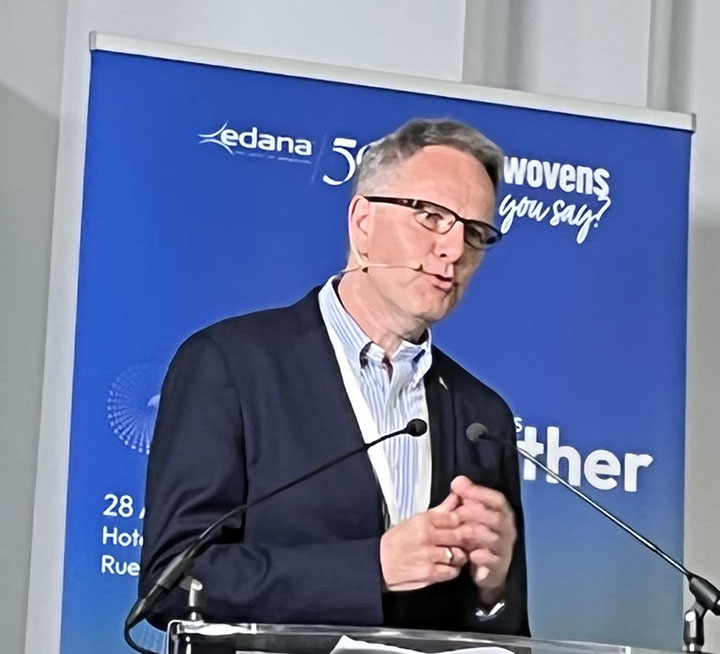A hail of silver bullets required – getting plastics to net zero
What if all plastics, including synthetic fibers and nonwovens, could become net zero in greenhouse gas emissions (GHGs) by 2050?
This tantalizing possibility is raised in a new report, Reshaping Plastics by Munich-based Systemiq. The report was, in turn, cited as an example of positive “big picture” thinking by Mikael Staal Axelsen, chairman of EDANA (the European Disposables and Nonwovens Association), during his keynote speech at the organization’s recent Nonwovens Get-together held in Brussels on April 28, 2022.
The event celebrated both EDANA’s 50th anniversary and the achievements of secretary general Pierre Wiertz, who has led the organization since 2004 and will retire in July.
EDANA was founded by just 12 companies in May 1971 and has now grown to represent 330 companies covering the entire nonwovens supply chain – from raw materials and machinery suppliers to the brands providing end-use products to a varied array of consumer and industrial markets.
Over the past half century, nonwovens production in Greater Europe has climbed fifty-fold, from around 63,000 tons in 1972 to 3.2 million tons in 2021. The industry in Europe has always been a net exporter and today over 25% of the raw materials it uses – both fiber and polymer-based – are from renewable resources. This share is poised to improve significantly in the coming years.
There is no “silver bullet” solution to significantly reducing plastic waste disposal and the industry’s GHG emissions, the Systemiq report finds, but upstream and downstream solutions are most effective when deployed together.
The European nonwoven roll goods industry employs 27,000 people and generates an annual €7.9 billion in revenues, based on the 83 possible end-use applications EDANA has identified, spanning 10 differentiated production technologies.
Reshaping Plastics
Referring to the findings of the Systemiq report, Staal Axelsen said that for the foreseeable future, the main material used for the production of nonwovens, especially for the absorbent hygiene industry, will be plastic.

“Embracing its use and focusing our efforts on reducing consumption and increasing recycling would make the biggest difference, without a doubt,” he said. “We would all like alternatives but have to be realistic – the production of bioplastics is just one percent of overall plastics production and capacities cannot be expanded fast enough. Not only one solution will work, and we need to be open minded in rethinking plastics, but we can make a huge difference if we succeed.”
No silver bullet
There is no “silver bullet” solution to significantly reducing plastic waste disposal and the industry’s GHG emissions, the Systemiq report finds, but upstream and downstream solutions are most effective when deployed together.
The ambitious adoption of circular economy approaches in the plastics value chain – applying upstream and downstream solutions together – can drive significant reductions in GHG emissions and waste disposal in the next decade and beyond. Yet it is still not enough to reach net-zero carbon emissions by 2050.
To achieve this, multiple less mature, innovative technologies and approaches need to be developed and deployed, in addition to proven circular economy levers to further decrease GHG emissions and decouple plastic from fossil fuel feedstocks.
These include the shift to green hydrogen, the use of carbon capture and storage (CCS) technologies to incinerators and steam crackers, shifting to bio-based polymers and electrifying steam crackers, which decrease GHG emissions and tend to decouple plastic from fossil fuel feedstocks.
Leadership
“How close the system comes to transformation will depend on the level of leadership shown by key decision makers across all stakeholder groups,” said Yoni Shiran, program director and partner at Systemiq. “The adoption of circular economy approaches across the plastics value chain can drive a 33% reduction in GHG emissions and a 46% reduction in waste disposal by 2030. It is both affordable and achievable within technical constraints but requires an ambitious combination of both upstream and downstream solutions. A new plastics system is within reach but will require bold action. It needs industry, public sector, investors, and civil society to come out of their ‘trenches’ and collaborate in a deeper way based on a shared fact-base – that was the main objective of our report.”
The transition will not be cheap, of course – Systemiq has made various cost projections pricing it at between $5-6 trillion.
“If anybody can achieve it, we are the people,” Staal Axelsen concluded.


